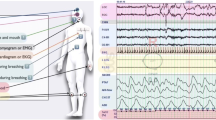Abstract
Background
The coexistence of obstructive sleep apnea (OSA) and chronic obstructive pulmonary diseases (COPD) is known as overlap syndrome (OS); it occurs in 10–20% of patients with OSA. Patients with OS have a higher risk of pulmonary hypertension and worse nocturnal hypoxemia than those with either disease alone. Differences may be seen according to severity of COPD, anthropometric measures, and polysomnography (PSG) features of patients. Recent studies have suggested that long-term use of continuous positive airway pressure for OSA is associated with worsening of coexistent COPD. This stresses the importance of identifying this subgroup of patients in order to provide adequate therapy.
Objectives
This study aims to describe the presence of OS among subjects at our institution and study its association to daytime hypercapnia, nocturnal hypoxemia, and severity of OSA and of COPD.
Methods
We reviewed the records of patients who underwent PSG and pulmonary function test (PFT) at our center since 2002. Data gathered from PSG and PFTs included respiratory disturbance index (RDI), apnea index, lowest nocturnal desaturation, forced expiratory volume in 1 s (FEV1), FEV1/forced vital capacity ratio, arterial blood gasses, and anthropometric measures.
Results
Five hundred forty-seven records were reviewed, but only 73 met all inclusion criteria for analysis. Thirty-six patients had COPD, 52 had OSA, and 29 had OS. The mean predicted FEV1 percent of all subjects was 80%, and the mean diurnal partial pressure of carbon dioxide (pCO2) was 39 mmHg. There were no significant differences in average pCO2 or RDI between subjects with OSA and OS. In all subjects, hypercapnia significantly correlated with worse RDI (p = 0.01) and with worse nocturnal desaturation (p = 0.01). During rapid eye movement (REM) sleep, those with FEV1 less than 80% predicted had higher RDI than those with higher FEV1 (p = 0.010).
Conclusion
In these preliminary results, the prevalence of OS in our population is similar to that previously reported. Daytime hypercapnia correlated with the more severe sleep-disordered breathing (SDB) and worse nocturnal hypoxemia in all subjects. Severity of obstructive ventilatory impairment is associated with worse SDB during REM sleep. Randomized trials to determine if PSGs are indicated in all patients with severe COPD should be considered. This is an ongoing study.







Similar content being viewed by others
References
Punjabi N (2008) The epidemiology of adult obstructive sleep apnea. Proc Am Thorac Soc 5:136–143. doi:10.1513/pats.200709-155MG
Yokoe T, MD MK, MD MH et al (2003) Elevated levels of C-reactive protein and interleukin-6 in patients with obstructive sleep apnea syndrome are decreased by nasal continuous positive airway pressure. Circulation 107:1129–1134. doi:10.1161/01.CIR.0000052627.99976.18
Bassetti C (2005) Obstructive sleep apnea and atherosclerosis. Am J Respir Crit Care Med 172:518–519. doi:10.1164/rccm.2506001
Resta O, Foschino Barbaro MP, Brindicci C et al (2002) Hypercapnia in overlap syndrome: possible determinant factors. Sleep Breath 6:11–17. doi:10.1055/s-2002-23151
Weitzenblum E, Chaouat A, Kessler R et al (2008) Overlap syndrome, obstructive sleep apnea in patients with chronic obstructive pulmonary diseases. Proc Am Thorac Soc 5:237–241. doi:10.1513/pats.200706-077MG
Weitzenblum E, Chaouat A (2004) Sleep and chronic obstructive pulmonary disease. Sleep Med Rev 8:281–294. doi:10.1016/j.smrv.2004.03.006
Banno K, Kryger M (2004) Factors limiting access to services for sleep apnea patients, guest editorial. Sleep Med Rev 8:253–255. doi:10.1016/j.smrv.2004.05.001
Acknowledgement
Supported by Sociedad De Investigación Cientifica (SODEINC), PO BOX 33060, Veterans Plaza Station, San Juan, PR 00933-0060
Conflict of interest
No affiliations with organizations with financial interest and no conflicts of interest were involved in this study.
Author information
Authors and Affiliations
Corresponding author
Rights and permissions
About this article
Cite this article
López-Acevedo, M.N., Torres-Palacios, A., Elena Ocasio-Tascón, M. et al. Overlap syndrome: an indication for sleep studies?. Sleep Breath 13, 409–413 (2009). https://doi.org/10.1007/s11325-009-0263-5
Received:
Revised:
Accepted:
Published:
Issue Date:
DOI: https://doi.org/10.1007/s11325-009-0263-5




